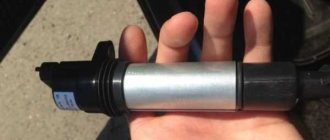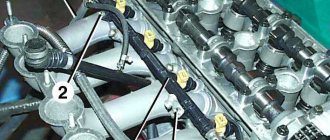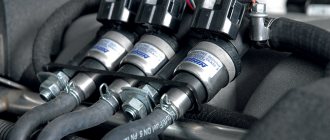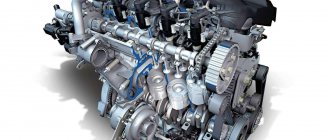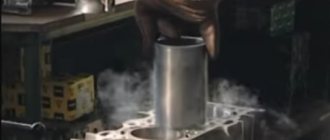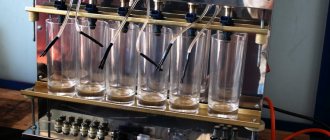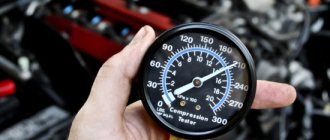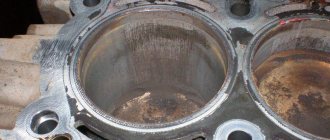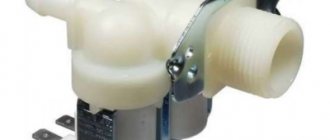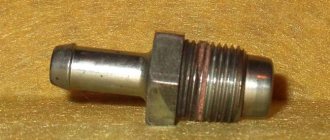The fuel injector is an indispensable component of the intake complex, guaranteeing uniform injection of fuel with subsequent distribution in the chamber and the formation of a mixture with air. The device is used in both gasoline and diesel units. Advanced motors use units with automatic feed control.
The fuel injector is an indispensable component of the intake complex.
Fuel injector - what is it?
Injecting fuel into the chamber is a complex process that consists of several stages. In power plants, not only the correct proportions of diesel fuel, gas or gasoline are calculated, but also the atomization technique, combustion timing and flame distribution.
The constant tightening of requirements for the environmental safety of vehicles forces engineers to modify the design of the intake system. And for a comprehensive solution to various problems, fuel injectors are used.
They are needed to convert liquid compositions into fine dust, which ignites more efficiently and provides higher efficiency.
Purpose of the device
A fuel injector is a structure that combines a high-pressure pump (HP pump) and an engine.
The device performs the following tasks:
- Responsible for the dosage of fuel when preparing the combustible mixture.
- Regulates fuel supply pressure.
- Forms a fine mixture (dust from atomized fuel and air) from liquid fuel.
In addition, the unit maintains the tightness of the equipment and ensures the most efficient combustion of fuel.
Location
The placement of injectors is determined by the modification of the intake system:
- Central (in front of the throttle valve in the intake pipe).
- Distributed (on each cylinder separately at the beginning of the pipeline).
- Direct (at the top of the cylinder walls).
The location of the injectors is determined by the modification.
Principle of operation
Gasoline or diesel composition is sent to the nozzle under appropriate pressure. The motor block gives an impulse to the injector magnet, causing the needle valve to start. It is responsible for the state of the channel (closed/open). The volume of fuel that enters the system depends on the duration of the incoming pulse.
Nozzle types
There are three types of parts most commonly used in modern vehicles:
- electromagnetic;
- electrohydraulic;
- piezoelectric.
Let's talk about each of them in more detail.
Electromagnetic
The valve responsible for supplying fuel to the nozzle of the part is in this case controlled by an induction coil with a movable core. And it, in turn, is controlled by software algorithms included in the electronic control unit. They operate depending on the degree of pressure on the accelerator.
Today, electromagnetic injectors are one of the most common. It is this type of device that is installed in the vast majority of gasoline injection engines that are equipped in passenger cars.
The structure of the electromagnetic version of the device and the principle of its operation are described in more detail above.
Electrohydraulic
It is a hybrid of electromagnetic and mechanical type devices. Used in modern diesel engines equipped with an ECU.
The operation of this type of device is based on the difference in fuel pressure. When the valve is in the closed state, the pressure is greater in the area of the piston located in the control chamber and less intense on the needle. When it is necessary to make an injection, a corresponding signal is received from the control unit and the solenoid valve opens slightly. At the same time, it distributes the fuel in such a way that it puts less pressure on the piston than on the needle. Thanks to this redistribution, it is in an open state. As a result, the needle rises and gasoline or diesel fuel can freely flow into the cylinder. It is at this moment that the actual injection occurs.
Piezoelectric
It is an improved version of the electro-hydraulic nozzle.
It has better characteristics in comparison with it, as it works very quickly. Thanks to this, several fuel injections can be made in a row in one stroke (usually 3 - 4). This is especially important for diesel engines (which determined the scope of application of this type of part). The design of the piezoelectric nozzle is exactly the same as that of the electrohydraulic one. The main difference is that in this case, instead of a solenoid valve, a piezoelectric element is installed on the device, which increases in size when electric current is applied to it.
When the valve is closed, the fuel exerts intense pressure on the control chamber piston and low pressure on the needle. When current is supplied to the piezoelectric element from the ECU, it increases, pushes the piston and thereby opens the valve. The pressure is redistributed - the most intense is on the needle. Fuel passes through it freely, resulting in injection.
Thus, the amount of fuel entering the cylinder when using this design is determined by the duration of exposure of the electric current to the piezoelectric element, as well as the fuel pressure.
It should be noted that there are other types of nozzles (for example, mechanical). However, they are gradually falling out of use.
Types of fuel injectors and their design
Depending on the method of controlling the fuel supply, injectors are divided into several types:
Mechanical models
This type is common on diesel engines. It operates as a result of fuel pressure acting on the locking mechanism. In the process of increasing the indicators, the needle is directed upward, provoking injection. After the pressure drops, it takes the previous position.
Mechanical models are common in diesel engines.
Mechanical injectors are less efficient than other types and are therefore rarely used in modern vehicles. At the same time, the parts have a simple and reliable design, which ensures a long service life.
Electromagnetic injectors
This type of injector is found on gasoline cars, including models with direct fuel supply. Depending on the functions they perform, injectors can be classified as starting or working. The second type carries out point or individual injection.
The design of the part includes the following components:
- Frame.
- Compartment for connection to the electrical circuit.
- Igloo.
- Seals.
- Nozzle.
- Valve excitation winding.
- Filter mesh and other elements.
Electromagnetic injectors are found on gasoline cars.
At the right moment, the motor unit sends voltage to the winding, contributing to the appearance of an electromagnetic field that affects the armature with the needle. At this time, the compression force of the spring decreases, the armature is retracted, and the needle rises, opening the injector nozzle. Then the nozzle control valve is activated and fuel is supplied at peak pressure. After the power supply to the winding is stopped, the spring returns the needle to its initial position.
Electrohydraulic devices
Electrohydraulic type models are found on diesel units. They can be installed on a standard fuel injection pump and a Common Rail complex, the peculiarity of which is the supply of fuel to the combustion chamber under high pressure.
The device contains the following parts:
- Nozzle through which fuel is directly supplied.
- Spring used to transmit force to the opening valve.
- Control chamber , where the piston is located under fuel pressure.
- Drain throttle.
- Electromagnetic element armature.
- Excitation winding, which creates an electromagnetic field .
- Fuel injection port.
Electrohydraulic devices are installed on diesel units.
During the cycle, the valve is in a closed state. The fuel in the system acts on the control chamber piston, and the injector needle is pressed tightly against the seat. The motor control unit sends voltage to the winding and the drain choke reopens. As a result, fuel is transferred to the main line.
The inlet mechanism prevents instant equalization of pressure in the chamber and at the inlet. Therefore, for some time, the force that acts on the piston decreases, but the pressure on the needle remains. Due to the difference in indicators, the needle rises and regulates fuel injection.
Piezoelectric parts
The device is found only on diesel engines and is considered the most advanced type of injector. This type facilitates instantaneous operation of the injection system, selection of the exact dosage and repeated supply of fuel. Such injectors are common in diesel units with Common Rail technology.
To assemble piezoelectric mechanisms, use:
- Igloo.
- Throttle block.
- Valve springs and pistons.
- Drain line.
- Filter.
- Discharge line and other parts.
Piezoelectric parts are considered the most advanced type of injectors.
The injector operates on the principle of changing the length of the piezoelectric element when voltage is applied. In the basic position the needle is on the seat. When the electronic control unit sends a signal to the piezo element, the latter influences the piston. The switch valve is actuated and the fuel goes to drain.
Let's sum it up
Do-it-yourself home inspection of the injectors of a gasoline injection engine and a diesel engine is real.
On both power plants, both the electrical part is monitored and the hydraulic component is inspected. Electrical diagnostics involve checking the resistance of the injector winding. This also includes a test for the integrity of wires supplying current. Hydrotesting is:
For heavy fuel vehicles, another verification method is relevant - tactile. The fuel line of each nozzle is probed for shocks and elevated temperatures.
If you are the owner of a car with an injection engine, you should know that for the injection system to work properly, it requires working injectors. You can check the operation of the injectors of an injection engine and troubleshoot problems with their operation yourself; you don’t have to immediately rush to a service station.
The concept of injector nozzles and the principle of their operation
Injectors are required to dose fuel into the combustion chambers of the engine. In the fuel system, they allow gasoline to be mixed with air. Thus, a flammable mixture is formed, which then ignites.
The injectors are:
• Electromagnetic - the valve monitors fuel access and regulates the atomization of the fuel mixture using the electronic engine control unit. There is a valve on the central distribution system in front of the throttle valve.
The principle of operation of the nozzles: an electronic sensor analyzes the volume of air supplied under pressure. The information received by the sensor enters the computer unit for further analysis (for example, engine temperature, air temperature). After this, the computer calculates the size of the volume of air in the fuel mixture required to ensure that the output coefficient of performance (efficiency) from the operation of the engine is as high as possible.
Why and when to check injectors
If you decide to buy a used car, or your car has already driven about 100 thousand km, then you should check the performance of the injectors or replace them.
The injectors (their condition) are affected by the quality of the fuel consumed. If low quality fuel is regularly poured into the tank, the injectors will not last long. They will have to be changed sooner than after 100 thousand km.
Symptoms of faulty injectors can be noticed. He will tell you about them:
• Unstable engine operation at idle.
• Increased fuel consumption.
• The engine does not start well.
• Exhaust gases have become more toxic.
• The ignition skips at idle.
• The car accelerates worse (even though the gas is squeezed to the max).
• If you notice at least one of the above symptoms, you should check the injector nozzles.
To extend the life of the injectors, it is advisable to:
• Fill the tank only with high-quality fuel.
• Regularly add various additives to the tank (sold in auto chemical departments).
• Clean the injectors every 40 thousand km (because they get clogged).
We look for faults and make repairs
Before checking the injector nozzles, pay attention to the fuel filter (it must be clean), the gas tank and the fuel pump screen (they may be clogged and deposited). Similar inspections are required after 30 thousand km for preventive purposes. If everything is in order with this part of the fuel system, proceed to check the injectors.
You can stop by the service station, where there is a special stand.
The liquid is supplied to the nozzles under pressure, and on the stand you will be able to see the operation of each sprayer (what spray dose it produces). To diagnose injectors, use a multimeter or ohmmeter (these are devices for measuring resistance of injectors). To determine the condition of the injector, you need to disconnect it from the high voltage wire. Now we check the injector with the device. There are low and high impedance injectors (the manufacturer's instructions will tell you about the type of injector). The resistance should be 2-5/12-18 ohms.
You can also check the injector nozzle at home. You can do this in several ways:
Start the engine. Touch the working nozzle with your hand - it should pulsate. If no vibration is felt, then the injector has failed. At idle speed, add speed and let the engine run a little. If you loosen the cap nuts that hold the injectors one by one, the engine speed will decrease. If the speed does not change, then the injector requires cleaning or replacement.
Diagnostic tool
Checking gasoline injectors yourself is possible if you have a diagnostic tool:
• On-board computer of the car (will help determine malfunctions in the engine control system).
• Pressure gauge (determines fuel pressure). Helps identify problems with the fuel pump pressure regulator and clogged fuel filters.
• LED for determining the polarity on the injectors (you can also determine the polarity on the ignition modules and coil).
• Ohmmeter or multimeter (determines the resistance of the injectors).
Checking power supply to injectors
If the ignition is turned on and one of the injector nozzles does not work, then check the presence of power to the injectors. To do this, you need to disconnect the wire block from the non-working injector. You need to attach the two ends of the wires to the battery, and touch the injector contacts with the other side of the wire. Now turn on the ignition.
Checking the windings
The nozzle on the injector requires immediate replacement if its resistance is higher or lower than 11-15 Ohms. This is determined using an ohmmeter.
How to check the resistance on the injector windings?
1. Remove the negative terminal from the battery.
2. Disconnect the block with wires from the injector.
3. Connect the ohmmeter leads to the electrical connector of the injector.
4. Compare the ohmmeter readings with the standard values (this is indicated in the manufacturer’s instructions).
Are there any differences between fuel injectors for diesel and gasoline engines?
Injectors for diesel engines have a smaller cross-section, and their operating principle is much more complex. To determine a breakdown, special knowledge is required. Such engines require increased tightness of the fuel system.
For such power plants, electromagnetic and piezoelectric models are used.
Gasoline engines have single- and multi-point injectors. The former regulate the fuel supply and are installed in front of the damper, while the latter include several injectors mounted in front of the pipelines. The device supplies gasoline to the combustion chamber, but has a non-separable design, so it cannot be repaired. The cost of components for gasoline engines is much lower than for diesel engines.
Functions and types of nozzles
A fuel injector, or injector, is a kind of valve, the operation of which is controlled by the engine control unit (ECU). This allows fuel under high pressure to be supplied in strictly limited portions and at a given point in time. Depending on the type of injection system, the injector can be installed in different places. So, with single injection it is located in front of the throttle in the intake manifold. In a multipoint injection system, the injectors are installed in the cylinder head in front of the valves. In this case, each cylinder has its own separate injector. In direct injection engines, the injectors are located at the top of the cylinder, delivering fuel directly into the combustion chamber.
Based on the control method (drive type), injectors are divided into the following types:
- mechanical;
- electromagnetic;
- electrohydraulic;
- piezoelectric.
Mechanical nozzle device
Mechanical injectors are used on diesel engines. The principle of their operation is based on the effect of fuel pressure on the locking spring. When the system pressure is higher than the spring resistance, the needle rises and injection occurs. After the pressure drops, the needle returns to its original position. It is worth noting that the pressure of such diesel engine injectors is very low, and therefore they are rarely used in the modern automotive industry.
Electromagnetic and hydromechanical injectors can have:
- nozzle valve with spherical profile;
- pin valve;
- disc valve.
How does an electromagnetic engine injector work?
This type of injector is used primarily in gasoline systems, including direct injection engines. According to their functional purpose, electromagnetic injectors are divided into starting (for example, in the K-Jetronic system) and working. The latter can be central (perform point injection) or individual (distribute fuel among the cylinders).
Signs of element failure
A malfunction or failure of an injector can be determined by the following signs:
- Increased fuel consumption with moderate thrust.
- Vehicle smoke.
- Strong engine vibrations.
Smoke from the vehicle is a sign of a breakdown.
Additional signs of failure include misfires. Also, a Check Engine indication may appear on the instrument panel, indicating the need to check the power unit.
A clogged fuel filter also negatively affects the throttle response of the unit. A damaged ignition system can cause jerking on a gasoline unit.
Fuel injector diagnostics
The specifics of injector diagnostics are determined by the type of part. In this case, diagnostics can be performed both in the service center and in the garage.
Power check
To assess the power supply you will need to do the following:
- Remove the power connector for the injector of the first cylinder.
- Connect a multimeter with settings for estimating DC voltage within 0-20 V.
- Start the car and analyze the measurement results. When in good condition, the injector gives short pulses.
- If there is no voltage coming to the power supply, turn off the car and check the wiring or find the defect during a visual inspection.
- Connect the injector of the first cylinder and repeat the checking procedure with the 2-4th elements.
To assess the power supply, you will need to remove the injector power connector.
Change resistance
First you need to clarify the injector model that is used on your vehicle. Next, you should determine the resistance of the coils inside the part.
After turning off the engine, you need to remove the power connectors, connect the multimeter and start it in the 0-200 Ohm measurement mode. It is important to analyze the resistance of each part. It must comply with the parameters stated in the technical specifications.
Diagnostics on the ramp
For diagnostics, you need to remove the fuel rail with fixed injectors. Next, you should connect the contacts to the ramp and injectors (if they were disconnected). The ramp is placed under the hood in such a way that it is possible to install a container with a scale under each part.
After this, you need to connect the fuel supply pipes and make sure they are securely fixed.
Clogged injectors
The next step is to turn on the ignition and crank the engine with the starter. It is better to carry out such actions together with a colleague.
While the second person is turning the engine, it is important to ensure that all injectors are working properly. Fuel injection must remain identical on all elements.
The final stage comes down to turning off the ignition and assessing the volume of fuel in the containers.
Testing at the stand
Auto repair shops have installed stands for diagnosing and restoring injectors. The test method for such a surface involves disassembling the ramp and vehicle injectors. The stand allows you to implement complex diagnostics, check the efficiency of fuel injection and determine electrical resistance. Some craftsmen build stands at home.
Cleaning the nozzle at home
To eliminate problems in the functioning of the injectors, it is worth cleaning them periodically. This is done in the standard way, with a special tool or using ultrasound, etc., without removing the mechanism from the motor.
Standard method
The most primitive and easiest method of cleaning fuel injectors involves pouring a special composition into the gas tank. The technique is used by owners of new vehicles or cars with a mileage of several thousand km. It involves adding a compound along with fuel to the tank to keep the engine and related systems clean.
The standard method involves pouring a special composition into the gas tank.
The method is not suitable for cars with complex contamination, because it aggravates the problem. In this case, you need to disassemble the engine on a prepared stand, dismantle the nozzles and clean them one by one.
Using these actions, you can find additional breakdowns and replace damaged components.
Cleaning without dismantling the engine
To wash the fuel pump without dismantling the power unit, you need to connect the washing station directly to the motor. This will remove accumulated dirt on the surfaces and fuel rail. It is enough to turn on the engine for 30 minutes, using neutral gear, and gradually supply the working mixture under pressure.
Preparing fuel injectors for replacement
The process of disassembling the injector begins with preparing the fixtures. The specifics of disassembly may differ for different car models and types of intake systems.
Trusted brands
To ensure that the sprayer lasts as long as possible, it is important to choose original products. And this applies to both electrical and mechanical models. Among high-quality analogues, you can buy devices from Siemens, Bosch, Delphi, OMVI, Hana.
How to remove an injector
Before dismantling the part, the pressure in the system should be released. Many car models have a special mechanism on the fuel rail. This is a special valve that is activated when pressed and allows fuel to flow out.
Then you need to get the ramp where the sprayers are held. Disassembly is carried out by disconnecting the connectors with wires. You can remove the elements by turning or rocking the mechanism.
Replacement with a new one
Having figured out how to remove the nozzle, all that remains is to install a new part in its place. To perform an action without errors, you need to have basic skills in solving such problems. The algorithm of actions may differ for each vehicle model.
If routine cleaning is required, remove the O-rings from all spray arms and discard them.
Main problems of fuel injectors
You can understand that there are problems with the nozzle by the following “symptoms”:
- jerking while moving;
- significant deterioration in dynamics;
- vibration or “triple” of the motor when changing gears or reducing speed;
- significant increase in fuel consumption.
If we are talking about a diesel engine, then the appearance of black smoke from the exhaust pipe is added to the listed symptoms. It appears due to excessive fuel entering the cylinder, which simply does not have time to burn completely.
Part malfunctions can occur for a variety of reasons. Here are the most common:
- increased amount of sulfur in fuel;
- corrosion;
- physical deterioration;
- clogging;
- incorrect installation;
- overheat;
- water ingress.
If the troubles are caused by the appearance of oxides on the internal walls of the device or its clogging, flushing will help. It can be done in several ways.
The first is to pour a special cleaning composition into the gas tank of the car. This is the simplest method. It is useful not only for cleaning, but also for preventing further contamination. But it is only suitable for relatively new cars. This is due to the fact that high-intensity contaminants cannot be removed in this way.
The second method is to use a special washing unit. It is available at every service station. This removes dirt from both the injectors and the fuel frame. It should be remembered that this method is not suitable for heavily worn engines. You can also clean the injectors using ultrasound at a car service center.
Finally, the third method is cleaning with removal. It involves removing the injectors from the cylinder head and subsequent manual cleaning. The method is used in the presence of heavy contamination. In addition, it allows you to identify the presence of faults.
If physical damage or severe wear is found on the injector, the only option is to completely replace it. You can do it yourself, without going to a car service. To do this, the part is removed from the cylinder block head, disconnected from the fuel supply system and wires leading to the computer, and then a new one is installed in its place in the reverse order.
